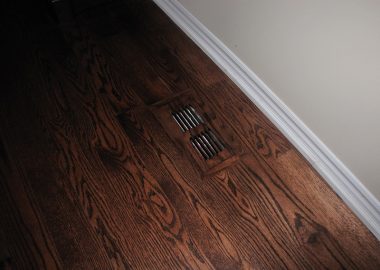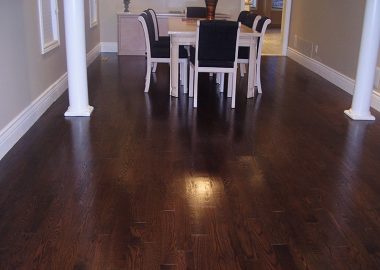


Wood flooring is any product manufactured from timber that is designed for use as flooring, either structural or aesthetic. Wood is a common choice as a flooring material and can come in various styles, colors, cuts, and species. Bamboo flooring is often considered a form of wood flooring, although it is made from a grass (bamboo) rather than a timber.
Hardwood flooring
Solid hardwood floors are made of planks milled from a single piece of timber. Solid hardwood floors were originally used for structural purposes, being installed perpendicular to the wooden support beams of a building known as joists or bearers. With the increased use of concrete as a subfloor in some parts of the world, engineered wood flooring has gained some popularity. However, solid wood floors are still common and popular. Solid wood floors have a thicker wear surface and can be sanded and finished more times than an engineered wood floor. It is not uncommon for homes in New England, Eastern Canada, and Europe which are several hundred years old to have the original solid wood floor still in use today.
Engineered
Engineered wood flooring is composed of two or more layers of wood in the form of a plank. The top layer (lamella) is the wood that is visible when the flooring is installed and is adhered to the core. The increased stability of engineered wood is achieved by running each layer at a 90° angle to the layer above. This stability makes it a universal product that can be installed over all types of subfloors above, below or on grade. Engineered wood is the most common type of wood flooring used globally.
The several different categories of engineered wood flooring include:
All timber wood floors are made from sawn wood and are the most common category of engineered wood flooring. They do not use rotary-peeled veneer, composite wood (such as HDF), or plastic in their construction.
Veneer floors use a thin layer of wood over a core that is commonly a composite wood product.
Acrylic-impregnated wood flooring uses a layer of wood that is impregnated with liquid acrylic then hardened using a proprietary process.
Laminate and vinyl floors are often confused with engineered wood floors, but are not; laminate uses an image of wood on its surface, while vinyl flooring is plastic formed to look like wood.
Installation systems
Wood can be manufactured with a variety of different installation systems:
- Tongue-and-groove: One side and one end of the plank have a groove, the other side and end have a tongue (protruding wood along an edge’s center). The tongue and groove fit snugly together, thus joining or aligning the planks, and are not visible once joined. Tongue-and-groove flooring can be installed by glue-down (both engineered and solid), floating (mostly engineered only), or nail-down (not recommended for most engineered).
- “Click” or Woodloc systems: there are a number of patented “click” systems that now exist. These click systems are either “unilin” or “fiboloc” A “click” floor is similar to tongue-and-groove, but instead of fitting directly into the groove, the board must be angled or “tapped” in to make the curved or barbed tongue fit into the modified groove. No adhesive is used when installing a “click” floor, making board replacement easier. This system not only exists for engineered wood floors but also engineered bamboo and a small number of solid floors (such as “parador solido click”) and is designed to be used for floating installations. It is beneficial for the Do-It-Yourself market.
- Floor connection system: There are a wide range of connection systems, as most of them are mill-specific manufacturing techniques. The general principle is to have grooves on all four sides of the plank with a separate, unconnected, piece that is inserted into the grooves of two planks to join them. The piece used for the connection can be made from wood, rubber, or plastic. This installation system allows for different materials (i.e. wood and metal) to be installed together if they have the same connection system.
- Wood flooring can also be installed utilizing the glue-down method. This is an especially popular method for solid parquet flooring installations on concrete sub-floors. Additionally, engineered wood flooring may use the glue-down method as well. A layer of mastic is placed onto the sub-floor using a trowel similar to those used in laying ceramic tile. The wood pieces are then laid on top of the glue and hammered into place using a rubber mallet and a protected 2×4 to create a level floor. Often the parquet floor will require sanding and re-finishing after the glue-down installation method due to the small size pieces.
- Floating installation: A floating installation is where the flooring is laid down in a glueless manner on top of a layer of underlay. The individual planks are locked together using a Woodloc system,and they are not glued or nailed down to the subfloor. By doing this the floor is floating above the underlay, and can be laid on top of existing tile or marble, without the risk of damaging the subflooring.
Floor finishes
The two most popular modern finishes for wood flooring are oil-modified urethane and water-based polyurethane. Within both categories there are many variations and other names used to describe the finish. Oil-modified urethane and water-based polyurethane also have very different refinishing and maintenance regimes.
- Natural shellacs, lacquers, and varnishes were used in the past, as were waxes, often blended with oils.
- Oil – Oiled floors have existed for several thousand years and is the most common floor finish used globally. Oil finished floors are made from naturally derived drying oils, and are not to be confused with petroleum based oils. Pre-finished oil floors can be UV cured. Most vegetable based oils are 100% natural and contain no VOCs.
- Brushed and oiled – Steel brushes are used in the direction of the grain which opens up the surface of the wood and removes splinters. The wood is then oiled.
- Polyurethane – Polyurethane floor finishes were first introduced around 1942. There are several types of polyurethane finishes that exist, but the two most common are oil-modified polyurethane and water-based polyurethane. Water-based urethane is harder than oil-modified polyurethane and is much safer for the user.
Buffing
Generally, hardwood floors need to be buffed every 3–5 years. The process usually takes about one day. Buffing refers to the process of using a stand up floor buffer. The floor is abraded with 180 grit screen on the buffer. This allows for the new coat of finish to mechanically adhere to the floor. This process works with great results as long as the floor hasn’t had any waxes or synthetic cleaners.
Refinishing
Sanding the finish off old wood floors and smoothing them out.
Floor sanding
Sanding provides a method for smoothing an installed floor, compensating for unevenness of the subfloor. Additionally, sanding is used to renew the appearance of older floors. Sanding using successively finer grades of sandpaper is required to ensure even stain penetration when stains are used, as well as to eliminate visible scratches from coarser sandpaper grades used initially. Prior to modern polyurethanes, oils and waxes were used in addition to stains to provide finishes.Beeswax and linseed oil, for example, are both natural crosslinking polymers and harden over time.
